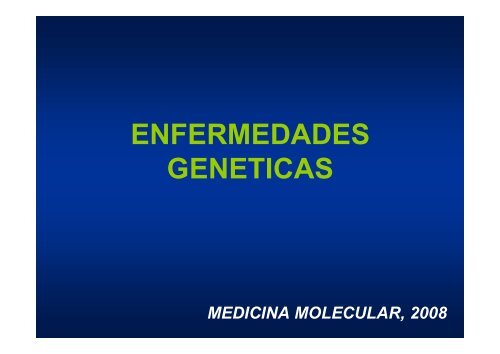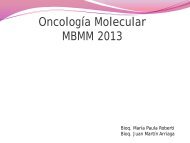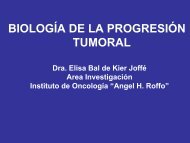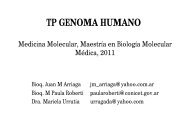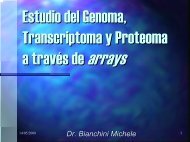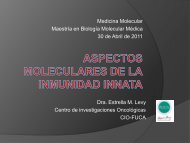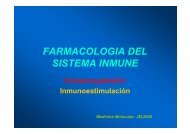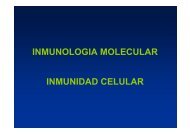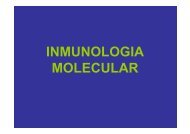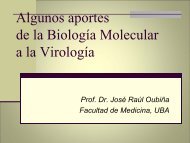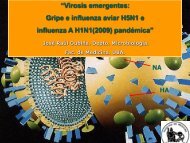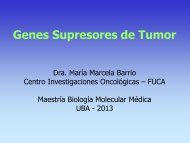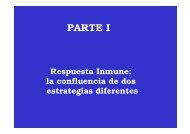ENFERMEDADES GENETICAS
ENFERMEDADES GENETICAS
ENFERMEDADES GENETICAS
You also want an ePaper? Increase the reach of your titles
YUMPU automatically turns print PDFs into web optimized ePapers that Google loves.
<strong>ENFERMEDADES</strong><br />
<strong>GENETICAS</strong><br />
MEDICINA MOLECULAR, 2008
METAFASE DE UN LINFOCITO DE SANGRE PERIFERICA. DAPI
Size of the genome<br />
2.91 Gbp<br />
Percent of genome<br />
classified as repeats 35<br />
Number of annotated genes<br />
26,383<br />
Percent of annotated genes<br />
with unknown function 42<br />
Number of genes<br />
(hypothetical and<br />
annotated-2001) 39,114<br />
Gene with the most exons<br />
Titin (234 exons)<br />
Average gene size 27 kbp<br />
Most gene-rich<br />
chromosome Chr. 19 (23<br />
genes/Mb)<br />
Least gene-rich<br />
chromosomes Chr. Y (5<br />
Percent of base pairs<br />
spanned by genes 25.5<br />
Percent of base pairs<br />
spanned by exons 1.1<br />
Percent of base pairs<br />
spanned by introns 24.4<br />
Percent of base pairs in<br />
intergenic DNA 74.5<br />
Longest intergenic region<br />
Chr. 13 (3,038,416 bp)<br />
Rate of SNP variation<br />
1/1250 bp<br />
Human Genome<br />
Overview<br />
Venter et al., Science<br />
(2001)
Human Gene Content: Surprisingly Few Genes<br />
Only 1% of genome are exons<br />
Protein-coding Gene Number: 30,000-40,000<br />
Human Genes:<br />
• Tend to live in GC-rich regions<br />
• Few new protein domains,<br />
many new domain architectures<br />
• Big expansions of some families . . .<br />
Smell receptors<br />
Immunoglobulins<br />
Growth Factors
Cariotipo normal
REGULACION DE LA EXPRESION GENICA<br />
POR METILACION (CpG)<br />
INACTIVACION DEL CROMOSOMA X = LIONIZACION<br />
GENES ACTIVOS = METILACION <br />
GENES INACTIVOS=<br />
METILACION
Human Populations<br />
All individuals share<br />
genome sequences<br />
which are 99.9%<br />
identical.<br />
The remaining 0.1% is<br />
responsible for all of the<br />
genetic diversity<br />
between individuals.<br />
Typing SNPs allows us to<br />
chart the evolution of the<br />
human race and its<br />
migration across the<br />
globe.
Chromosomal location of repetitive DNA
Human genes vary enormously in size and exon<br />
content
GENE DENSITIES
GENES WITHIN GENES
Gene families<br />
• Members may exhibit high sequence<br />
homology<br />
• sometimes contain a highly conserved<br />
domain (e.g. SOX box)<br />
• sometimes contain a very short conserved<br />
“motif” (e.g. DEAD box, asp-glu-ala-asp RNA helicases)<br />
• superfamilies (e.g. Ig superfamily)<br />
• sometimes clustered (e.g. globin genes)<br />
• Often associated with truncated and non<br />
processed pseudogenes
DEFINICIONES<br />
• LOCUS: Segmento de DNA heredado de forma<br />
Mendeliana<br />
• GENOTIPO: Información contenida en un locus<br />
• ALELOS: Diferencias normales en el genotipo para un<br />
gene determinado<br />
• HOMOCIGOTA: Alelos idénticos<br />
• HETEROCIGOTA: Alelos diferentes<br />
• FENOTIPO: Características visibles de un individuo<br />
• DOMINANTE: Alelo heterocigota reconocido en el<br />
fenotipo<br />
• RECESIVO: Alelo heterocigota no reconocido en el<br />
fenotipo<br />
• CODOMINANTE: Ambos alelos son co-expresados
SNPs are Very Common<br />
• SNPs are very common in the human<br />
population.<br />
• Between any two people, there is an<br />
average of one SNP every ~1250 bases.<br />
• Most of these have no phenotypic effect<br />
– Venter et al. estimate that only
RFLP<br />
(Restriction Fragment Length<br />
Polymorphisms)
Genome Sequencing finds<br />
SNPS<br />
• The Human Genome Project involves<br />
sequencing DNA cloned from a number of<br />
different people.<br />
[The Celera sequence comes from 5 people]<br />
• Even in a library made from from one person’s<br />
DNA, the homologous chromosomes have<br />
SNPs<br />
• This inevitably leads to the discovery of SNPs<br />
- any single base sequence difference<br />
• These SNPs can be valuable as the basis for<br />
diagnostic tests
We describe a map of 1.42 million single nucleotide polymorphisms (SNPs) distributed throughout the<br />
human genome, providing an average density on available sequence of one SNP every 1.9 kilobases.<br />
These SNPs were primarily discovered by two projects: The SNP Consortium and the analysis of clone<br />
overlaps by the International Human Genome Sequencing Consortium. The map integrates all publicly<br />
available SNPs with described genes and other genomic features. We estimate that 60,000 SNPs fall<br />
within exon (coding and untranslated regions), and 85% of exons are within 5 kb of the nearest SNP.<br />
Nucleotide diversity varies greatly across the genome, in a manner broadly consistent with a standard<br />
population genetic model of human history. This high-density SNP map provides a public resource for<br />
defining haplotype variation across the genome, and should help to identify biomedically important<br />
genes for diagnosis and therapy.
<strong>ENFERMEDADES</strong> <strong>GENETICAS</strong> (3-5%)<br />
• Trastornos cromosómicos<br />
• Trastornos mendelianos o monogénicos<br />
• Enfermedades multifactoriales<br />
• Formas no-clásicas de enfermedad genética<br />
(imprinting genómico, etc)<br />
• Trastornos mitocondriales<br />
• Mutaciones que surgen en células somáticas<br />
diferenciadas
Mutations<br />
A change in the DNA sequence of the<br />
gene<br />
All cells acquire mutations as they<br />
divide<br />
rate of approx 10 -6 per gene per cell<br />
Mutations can alter protein product of<br />
DNA, stop gene working or activate<br />
gene
Types of Mutation<br />
• Deletion - DNA missing<br />
• Insertion - extra DNA inserted<br />
• Expansion - DNA repeat size has<br />
increased<br />
• Point Mutation - change in one<br />
base
Types of Mutation (in coding<br />
sequence)<br />
AGC TTC GAC CCG<br />
AGC TCG ACC CG<br />
AGC TTC CGA CCC G<br />
Wild type<br />
Deletion<br />
Insertion<br />
AGC TTC TTC GAC CCG Expansion<br />
ATC TTC GAC CGG<br />
ATC TGA<br />
Point<br />
mutation<br />
Nonsense<br />
‘stop’
Cariotipo normal
<strong>ENFERMEDADES</strong> <strong>GENETICAS</strong><br />
• Trastornos cromosómicos<br />
• Trastornos mendelianos ó monogénicos<br />
• Enfermedades multifactoriales<br />
• Formas no clásicas (imprinting genómico)<br />
• Trastornos mitocondriales<br />
• Mutaciones en células somáticas<br />
diferenciadas
PENETRANCIA<br />
Está definida por la edad y<br />
frecuencia con que se<br />
expresa una mutación<br />
determinada
EXAMPLES OF DIFFERENT TYPES OF MUTATIONS<br />
Type of mutations<br />
Example<br />
Genome<br />
Abnormal Chromosome set<br />
Chromosome<br />
Triploidy, tetraploidy<br />
Abnormal number of autosomal chrom. Trisomy 21, 18, 13<br />
Abnormal number of sex chromosomes<br />
Klinefelter and Turner syndrome<br />
Translocation Acute myeloid leukemia t (9;22)<br />
(q34:q11) “Philadelphia chromosome”<br />
Deletion Cri du chat syndrome 5p-<br />
Gene<br />
Deletion<br />
Duplication, insertion<br />
Triplet expansion<br />
Missense point mutation<br />
Splicing mutation<br />
Duchenne muscular dystrophy.<br />
Thalassemia<br />
Charcot-Marie-Tooth Type I<br />
Fragile X syndr., Huntington disease<br />
Cystic fibrosis<br />
Globin
Frequent Chromosome Abnormalities<br />
Disorder Chromosomal Genotype Frequency<br />
Abnormal no. of chromosome sets<br />
Triploidy 69XX, 69XY Frequent in miscarriage<br />
Tetraploidy 92XX, 92XY Frequent in miscarriage<br />
Abnormal no. of autosomes<br />
Trisomy 21 1/600<br />
Trisomy 18 1/5000<br />
Trisomy 13 1/15.000<br />
Abnormal no. of sex crhomosomes<br />
Klinefelter syndrome 47XXY 1/1000 males<br />
XYY-syndrome 47XYY 1/1000<br />
Turner syndrome 45X0,45X/46X0,45X/46XY 1/10.000 females<br />
(mosaicism)<br />
Triple-X syndrome XXX 1/1000
Principles of Molecular Medicine, 1998
SINDROMES KLINEFELTER Y TURNER
<strong>ENFERMEDADES</strong> <strong>GENETICAS</strong><br />
• Trastornos cromosómicos<br />
• Trastornos mendelianos ó monogénicos<br />
• Enfermedades multifactoriales<br />
• Formas no clásicas (imprinting genómico)<br />
• Trastornos mitocondriales<br />
• Mutaciones en células somáticas<br />
diferenciadas
Selected Monogenic Disorders<br />
Autosomal dominant disorders<br />
Familial hyperlipidemia<br />
Familial hypercholesterolemia<br />
Huntington disease<br />
von Willebrand disease<br />
Autosomal recessive disorders<br />
Cystic fibrosis<br />
Phenylketonuria<br />
Sickle-cell anemia<br />
Hemochromatosis<br />
-Thalassemia<br />
Tay-Sachs disease<br />
1-antitrypsin deficiency<br />
Polyposis of the colon<br />
Hereditary nonpolyposis colon cancer Familial breast cancer<br />
X-linked disorders<br />
Color blindness<br />
Hemophilia A<br />
Hemophilia B<br />
Duchenne muscular dystrophy<br />
Becker muscular dystrophy<br />
Fragile X syndrome
Cystic fibrosis<br />
transmembrane regulator<br />
(CFTR)
Destrucción del tejido<br />
pulmonar en Fibrosis<br />
Quística
<strong>ENFERMEDADES</strong> <strong>GENETICAS</strong><br />
• Trastornos cromosómicos<br />
• Trastornos mendelianos ó monogénicos<br />
• Enfermedades multifactoriales<br />
• Formas no clásicas (imprinting genómico)<br />
• Trastornos mitocondriales<br />
• Mutaciones en células somáticas<br />
diferenciadas
<strong>ENFERMEDADES</strong><br />
MULTIFACTORIALES O RASGOS<br />
GENETICOS COMPLEJOS<br />
ASMA<br />
ARTRITIS REUMATOIDE<br />
DIABETES MELLITUS<br />
ESQUIZOFRENIA<br />
HIPERTENSION
DESVIACIONES DE LEYES<br />
MENDEL<br />
• PENETRANCIA / NO PENETRANCIA<br />
• MUTACIONES NUEVAS<br />
• MOSAICISMO<br />
• ANTICIPACION<br />
• IMPRINTING<br />
• HERENCIA DIGENICA
SINDROME DE RETARDO<br />
MENTAL POR X FRAGIL
Principles of Molecular Medicine, 1998
Principles of Molecular Medicine, 1998
<strong>ENFERMEDADES</strong> <strong>GENETICAS</strong><br />
• Trastornos cromosómicos<br />
• Trastornos mendelianos ó monogénicos<br />
• Enfermedades multifactoriales<br />
• Formas no clásicas (imprinting genómico)<br />
• Trastornos mitocondriales<br />
• Mutaciones en células somáticas<br />
diferenciadas
SINDROME DE PRADER-WILLI<br />
Hiperfagia,Hipotonia,<br />
Hipogonadismo, Obesidad<br />
SINDROME DE ANGELMANS<br />
“Sindrome de Happy Puppet”
Principles of Molecular Medicine, 1998
Principles of Molecular Medicine, 1998
<strong>ENFERMEDADES</strong> <strong>GENETICAS</strong><br />
• Trastornos cromosómicos<br />
• Trastornos mendelianos ó monogénicos<br />
• Enfermedades multifactoriales<br />
• Formas no clásicas (imprinting genómico)<br />
• Trastornos mitocondriales<br />
• Mutaciones en células somáticas<br />
diferenciadas
Principles of Molecular Medicine, 1998
Principles of Molecular Medicine, 1998
Principles of Molecular Medicine, 1998
Principles of Molecular Medicine, 1998
<strong>ENFERMEDADES</strong> <strong>GENETICAS</strong><br />
• Trastornos cromosómicos<br />
• Trastornos mendelianos o monogénicos<br />
• Enfermedades multifactoriales<br />
• Formas no-clásicas de enfermedad genética<br />
(imprinting genómico, etc)<br />
• Trastornos mitocondriales<br />
• Mutaciones que surgen en celulas somaticas<br />
diferenciadas


